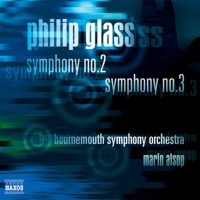Good performance/Screwed up movement order
4
By Sappho88
I like the performances very much. Especially the 2nd movement of the 3rd Symphony. The score has all separate notes and the slurs added by the performers really makes it great!
The movements of the 3rd Symphony are supposed to be attacca, i.e. played without pause into one another. On my iTunes it goes from the 1st movement to the 3rd!!!!!!! I haven't found a work around. This is truly dreadful. It means I'm going to stop buying from iTunes and just get the CD's and load them, or download from elsewhere, a place that actually cares about classical music.
OMG, this is bad
1
By DBMount
Alslop's asleep at the wheel as usual. Combine that with less than classic Glass and you've a bad combination. Sample the second movement of the symphony, "Abdulmajid". Sounds like a film score for a bad version of Aladdin, it just goes on and on in this boring loop.
Stay away! Buy some Steve Reich or John Adams.
Glass Delivers
5
By GustafNeilson
Along with his colleague John Adams, Philip Glass is the most familiar of the modern minimalists. Yet like Adams, Glass seems to be building a greater communicative sense with each new work I hear. These two symphonies were composed in the early nineties, and Naxos is now providing a 2003 recording of the Bournemouth Symphony Orchestra led by the insightful Marin Alsop. This is the same group of artists that played the wonderful version of Adams' "Shaker Loops" this past year, and this recording of Glass' works equals that one for dramatic insight and virtuosic preciseness.
A strings-only piece, Symphony #3 (23:58) has four conventional movements which build in drama and texture. It contains many of Glass' signature sounds with mono-tonal melodies that spiral in larger and larger circles and chords that feel like they are beating down an urban thunderstorm of clandestine activity - jabbing, throbbing, chugging - as they do in the second movement. Yet the music reflects some of his most gentle work especially in the first and third movements. There is an unexpectedly beautiful violin solo in the middle of the third movement that runs initially counter to his quietly driving sequential style until they eventually meld together. The drama turns fiery in the last movement as it broadens into an exciting albeit measured gallop, at the same time not sacrificing the virtuosity of the expert playing by the Bournemouth string section.
Symphony #2 (43:14) is a larger scale piece that makes dramatic sense to be played after the third, as it is a more ambitious work. It slowly builds in intensity with very broad strokes that deepen and darken when it comes to the bass-lines and the repetitive use of contrasting woodwinds. There is a vividly harrowing sense of adventure to the first movement that this section would not be inappropriate to be used as background movie music for a daring escape aboard a hot air balloon crossing the Alps. There is more of an orchestral sense to the second movement and an increasing ambiguity in tone that heightens the drama considerably with yet a new set of pronounced textures. The finale has almost a battle-cry exuberance but with a swooping, sinuous dramatic power with the addition of brass and even bells to the strings and woodwinds. The last movement truly feels like the culmination of what Glass has presented before in both symphonies.
Beautifully recorded at "The Concert Hall, Lighthouse, Poole" in Dorset, UK, this recording verifies that Glass' oeuvre is more than his famous operas often in collaboration with Robert Wilson. Producer-engineer Tim Handley has done an excellent job of keeping the impeccable sound in check throughout. Highly recommended!
WOW
5
By RockCityEscapee
What a fresh look at classical! You get a sense of rock and roll played by a symphony of angels, or maybe hells angels sense the music is especially reminiscent of metal and rock and roll. The dark bass tones are great and the simple repeating rhythms and themes are mesmerizing. I liek classical in a general superficial way, but the music on this album gives me new hope and a fresh perspective. I defintely recommend this album! The first part of Symphony #3 is worth album alone.
Not at all inspiring
1
By Boolez
Glass may not be as talented as Babbitt or Stockhausen but Alsop should at least pretend to be interested in these pieces. Perhaps she's trying to turn people away from his music, which is a good thing, but she shouldn't sacrifice her reputation with these flat and insipid readings.
